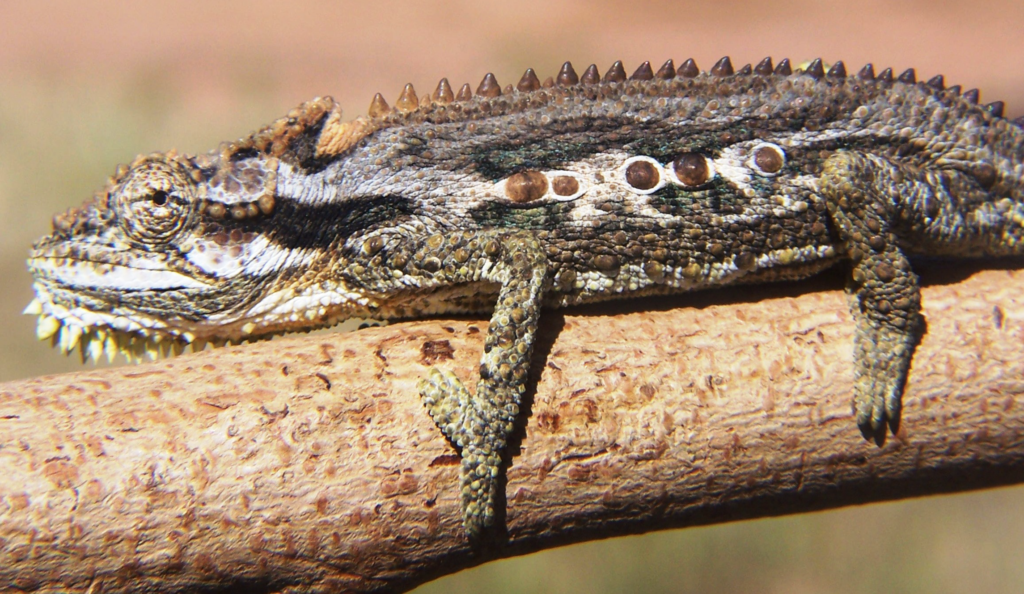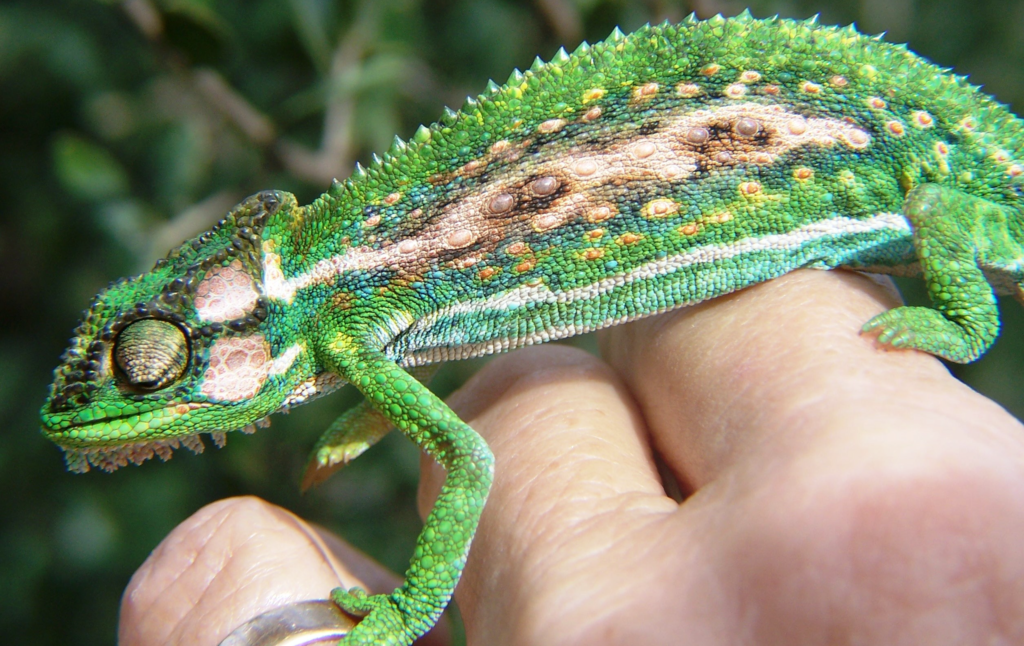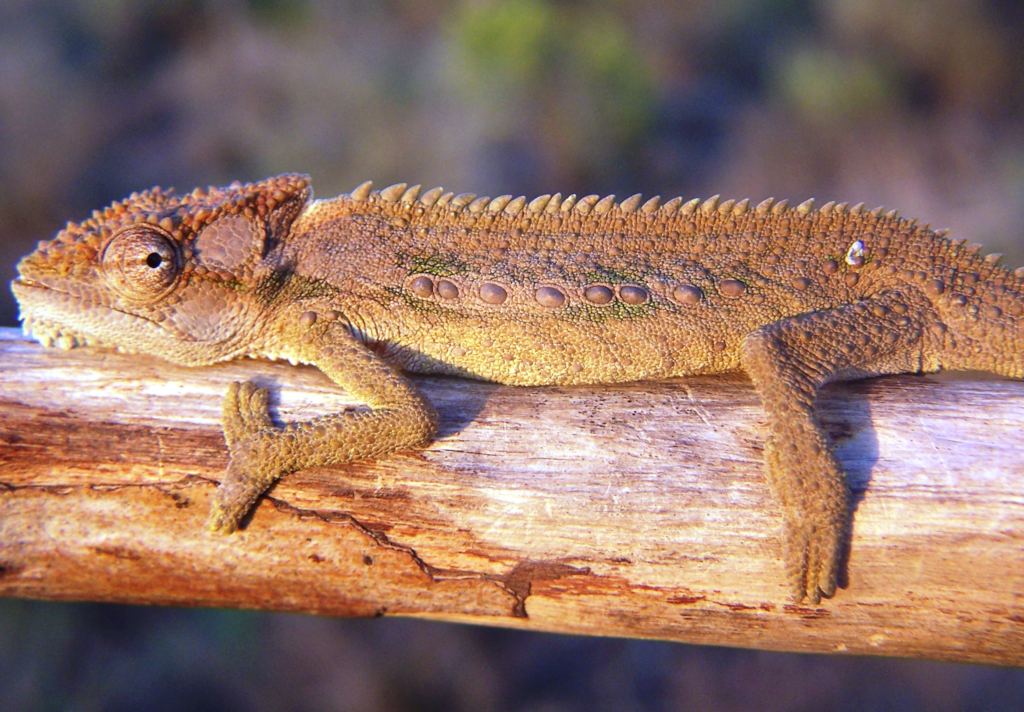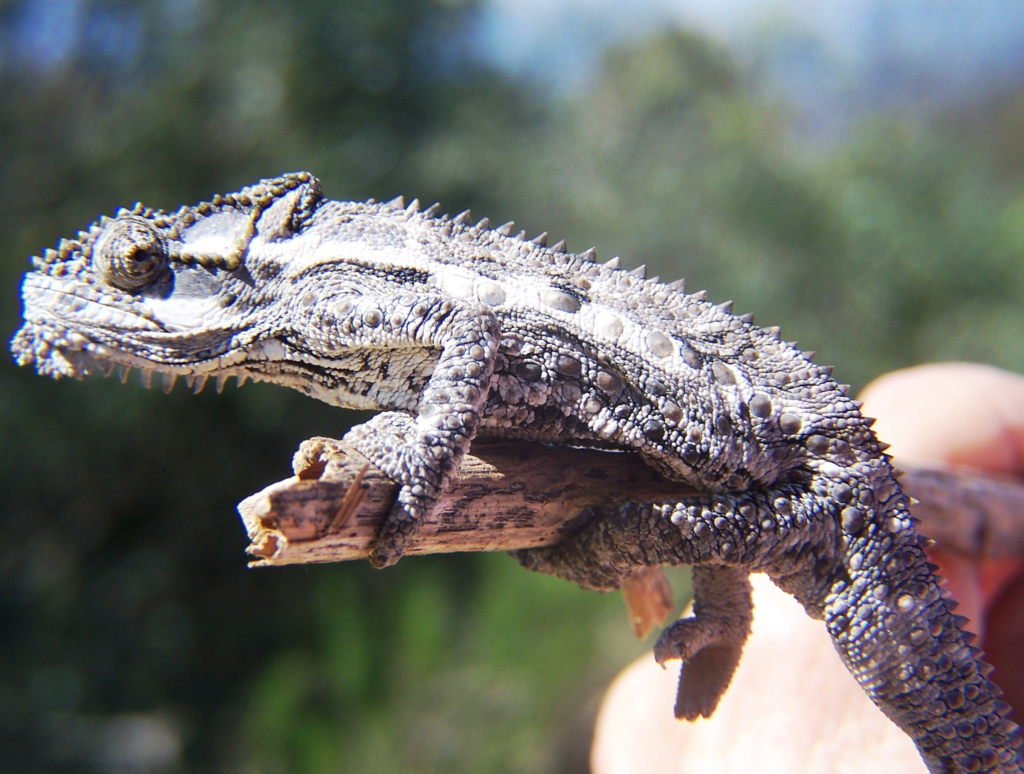There is a very curious parallel in the problems and aspects of classification and identification of haworthias and chameleons that I personally find a bit mystifying. Classification of succulent plants and especially Haworthia is often done outside of mainstream science, which means that it is not done by trained professional botanists, who can stand in the intellectual arena with academics and degreed intellectuals. It has been pointed out to me that this is the problem in Haworthia and also why professionals do not want to attempt to resolve the issue because the nomenclature has been so confused and complicated by all the bungling that has taken place. Having been on the fringes, and indeed even failed attempting to cross the bridge into academia, I find it very difficult indeed to reconcile my life experience in the amateur arena with what I encounter from the professional one. This is because I have observed an ever widening gap between the perceptions of the non-science individual compared to that of the professional. My interest in chameleons is simply another aspect of my interest and passion for living things and I am distressed that the knowledge and understanding of these fascinating animals, as with Haworthia, is so clouded by ignorance and confusion.
It is a bit problematic for me to explain why I think classification and plant names is such a big issue and why it is important to me, but fundamental to me is trying to understand and know something about plants and animals as an extension of my life experiences.
Recently a very welcome and valuable booklet, Chameleons of Southern Africa has been authored by Krystal Tolley and Marius Burger and published by Struik Publishers (Cape Town). What makes it so interesting for me beyond my interest in the animals themselves, is the remarks the authors make in the preface in respect of writing the species accounts. The problem of finding identifying characters was a key issue and there is constant reference to confusion. There is of course no statement about what a chameleon species actually is and there is this curious statement, “There are few consistencies of identification characteristics, and we admit that we sometimes initially identify a chameleon by means of ‘gut feeling’.” What makes this so curious is that there is nothing in the booklet to indicate there is any more to the mystery of identification and how a final identification could be made to possibly help the even more than average individual to arrive at own conclusion.
In Haworthia (as indeed is the case in many plant genera) the description of species has been based on a basis of simple visual (morphological) difference, with barely any consideration of variation and in the total absence of a definition of a species beyond the assumption that if they look different they are different (species).
One has to ask what is it that is referred to as ‘gut-feeling’? I have often heard and read that classification and taxonomic statement is a matter of opinion and felt compelled to respond by quoting a writer who made the distinction between mere opinion and informed opinion. “Gut-feel” may vary from the instant response of the ignorant to a fleeting image, to the deeply considered intuitively driven reservation of another who is highly informed and who has a vast bank of experience, images and literature to draw from.
The significant thing is that any decision-making in the chameleon booklet has been facilitated by results from DNA analysis – *please see the footnote. Now I must make it clear that I am not attacking the book or the authors. I want to draw attention to the problems inherent in a methodology which amounts to nothing more than saying “trust me”, and the very serious problem that own judgment is by implication quite useless. As a very knowledgeable observer wrote to me “Our own eyes and brains are seemingly no longer good enough to serve the world – well that is what the RNA-DNA lab technicians are trying to tell us.” There have been several attempts to evaluate the classification of Haworthia by DNA sequencing that do little more than ring alarm bells. Without any pretence at understanding all the convolutions of genetics and the repository of DNA in all its forms, I would have to ask again, what does one do to organize one’s scepticism about the results that are thrust upon one? If the total facies that an individual organism presents to the eye and senses is not a reasonable representation of the information encoded in the DNA, then we are absolutely helpless. Could one say that we have been put into this creation without the sensory capabilities to distinguish and discriminate anything?
Recently I submitted photographs of two chameleons to an authority for identification stating that I thought they were not the Karoo Dwarf. The reply I received was “It looks like the Karoo Dwarf. What makes you think it is not?” Apart from the fact that I had already given reasons, the truth is that my correspondent could not possibly have said why he thought it did look like the Karoo Dwarf, thereby shifting the responsibility back on to me. Are we stuck with the sad and unavoidable fact that unless one can get a DNA result, one cannot know what you are looking at?
What has now happened with respect to Haworthia DNA where we have the same dreadful problem of identification and understanding? I have elsewhere (see Haworthia Update 3 (Ch 3: p92) discussed the papers by Messrs. Treutlein et al and I summarily dismiss what I think may be unpublished results by another source I must politely keep to myself. There was a rather immodest statement by Messrs. Wallace and Noll published in Haworthiad that promised to unfold the problems of Haworthia classification by DNA analysis. The results have never been disclosed and there is a disconcerting failure by the authors to respond to any inquiry. More recently Dr. Syd Rhamdhani has also been busy sequencing the DNA of a range of Haworthia and species of related genera. The work was initiated in an attempt to relate variability to habitat diversity, but to preclude a total negative result it was deemed advisable to widen the scope to ensure that the methodology was applicable at a broader scale. The results demonstrated, at least from my personal perspective, a complete failure to relate the DNA sequences with the realities of the classification of at least the semi-rational mind of an experienced and informed observer.
Group1A
Group 1Aa
| Code | Collector Number | Taxon name | Subgenus | Locality | Source |
| 54 | MBB 7128 | angustifolia var. baylissii | Haworthia | Wellsgate, E. of Kirkwood | Field |
| 47 | MBB 6843 | marumiana var. reddii | Haworthia | Inverbolo, Stutterheim | Sheilam |
| 58 | MBB sn | truncata v. maughanii | Haworthia | Sheilam |
Group 1Ab
| Code | Collector Number | Taxon name | Subgenus | Locality | Source |
| 35 | JDV 90/57 | monticola var. asema | Haworthia | S. of Kruis River | Field |
| 40 | JDV 97/128 | mucronata var. mucronata | Haworthia | SE of Barrydale | Sheilam |
| 6 | SR&TDsn 4 | angustifolia | Haworthia | Mountain Drive (Gtown) | Sheilam |
Group 1Ac
| Code | Collector Number | Taxon name | Subgenus | Locality | Source |
| 32 | EvJ 17548 | cymbiformis var. transiens | Haworthia | Horee | Field |
| 52 | MBB 7032 | mutica var. mutica | Haworthia | Rietfontein | Sheilam |
Group1B
Group 1Ba
| Code | Collector Number | Taxon name | Subgenus | Locality | Source |
| 30 | PVB 7047 | zantneriana | Haworthia | N. of Redcliffe, Willowmore | Sheilam |
| 62 | MBB sn | reticulata | Haworthia | Bosfontein | Sheilam |
| 48 | MBB 6875 | maraisii | Haworthia | Cogmanskloof, Ashton | Shadowlands |
| 51 | MBB 6985 | rossouwii var. calcarea | Haworthia | De Hoop |
Group 1Bb
| Code | Collector Number | Taxon name | Subgenus | Locality | Source |
| 33 | GM 623 | marxii | Haworthia | Rooi Nek Pass S. of Laingsberg | |
| 36 | JDV 91/91 | cymbiformis var. setulifera | Haworthia | Rainbow Valley | Sheilam |
| 4 | SR & TDsn 2 | cooperi var. gracilis | Haworthia | Mayfair (Gtown) | Field |
| 18 | SR & BBsn Site 5- 27/6 | cooperi var. viridis | Haworthia | Kaboega, Dassiekop NE of farmhouse | |
| 15 | SR & BBsn Site 3- 26/6 | cymbiformis var. obtusa | Haworthia | Glen Avon falls | Field |
| 16 | SR & BBsn Site 2- 27/6 | cooperi var. ‘puberula’ | Haworthia | Kaboega, W of Wilgefontein | Field |
| 1 | SR&TD 719 | cymbiformis var. incurvula | Haworthia | Platosvale | Field |
| 21 | SR & BBsn Site 3- 18/10 | cooperi var. viridis | Haworthia | Kaboega, De Plaat | Field |
| 24 | SR & BBsn Site 1- 19/10 | cooperi var. spec.1 | Haworthia | Kaboega, Kaboegapoort | Field |
| 23 | SR & BBsn Site 1- 19/10 | cooperi var. spec.3 | Haworthia | Kaboega, Kaboegapoort | Field |
| 25 | SR & BBsn Site 1- 19/10 | cooperi spec. 4 | Haworthia | Kaboega, Kaboegapoort | Field |
| 22 | SR & BBsn Site 4- 18/10 | cooperi var. viridis Grassland form | Haworthia | Kaboega, W of Wilgefontein | Field |
| 38 | JDV 93/45 | cymbiformis var. obtusa | Haworthia | Kagasmond | Sheilam |
| 27 | SR & BBsn Site 1- 19/10 | cooperi spec.2 | Haworthia | Kaboega, Kaboegapoort | Field |
| 39 | JDV 94/98 | decipens var. xiphiophylla | Haworthia | W. of Coega | Sheilam |
| 64 | BBsn | aristata | Haworthia | E of Hopewell farm | Field |
Group 1Bc
| Code | Collector Number | Taxon name | Subgenus | Locality | Source |
| 13 | SR & BBsn Site 1- 18/10 | cooperi typical | Haworthia | Kaboega, Gertpiets area | Field |
| 26 | SR & BBsn Site 2- 19/10 | cooperi var. viridis | Haworthia | Kaboega, back of the Dam (Spekboomberg) | Field |
| 44 | MBB 6791/4 | cooperi var. picturata | Haworthia | Andrieskraal | Sheilam |
| 3 | SR & TDsn 1 | cooperi var. pilifera | Haworthia | Mayfair (Gtown) | Field |
Group 1Bd
| Code | Collector Number | Taxon name | Subgenus | Locality | Source |
| 63 | MBB sn | parksiana | Haworthia | Mossel bay | Sheilam |
| 50 | MBB 6983 | rossouwii var. rossouwii | Haworthia | Soutkloof, Napier | Sheilam |
| 67 | MBB sn | pulchella var. pulchella | Haworthia | Constable Station | Sheilam |
| 43 | MBB 6762 | puchella var. globifera | Haworthia | Touwsberg, Little Karoo | Sheilam |
Group2A
Group 2Aa
| Code | Collector Number | Taxon name | Subgenus | Locality | Source |
| 46 | MBB 6829 | Poellnitzia rubiflora | NA | Rooikloof | Shielam |
| 71 | AJ290302 | Poellnitzia rubiflora | NA | Genbank |
Group 2Ab
| Code | Collector Number | Taxon name | Subgenus | Locality | Source |
| 73 | MBB sn | Aloe bowiae | NA | ??? | Sheilam |
| 9 | SR&TD S3-29/8 | Aloe speciosa | NA | Plutosvale | Field |
| 10 | SR&TD S6-29/8 | Aloe africana | NA | Bothas Hill (Grahamstown) | Field |
| 11 | SR&TD S7-29/9 | Aloe lineata | NA | Stones Hill (Grahamstown) | Field |
| 72 | AJ290289 | Aloe vera | NA | Genbank |
Group 2Ac
| Code | Collector Number | Taxon name | Subgenus | Locality | Source |
| 7 | SR & TDsn 6 | attenuata | Hexang. | Plutosvale | Field |
| 34 | JDV 85/145 | scabra var. morrisiae | Hexang. | Schoemanspoort | Sheilam |
| 31 | EvJ 16840 | attenuata var. glabrata | Hexang. | Collywobbles | Sheilam |
| 56 | MBB 7179 | viscosa | Hexang. | Constantia, W. of Willowmore | Sheilam |
| 65 | MBB sn | venosa var. venosa | Hexang. | Breede Riv., Swellendam | Sheilam |
| 41 | JDV 1942 | attenuata var. attenuata | Hexang. | Soutkloof, Addo | Sheilam |
| 28 | Clark & Pienaar 120 | venosa var. tessellata | Hexang. | Farm Hughdale 161, Kikvorsberge (Noupoort Region, N. Cape) |
Group 2Ad
| Code | Collector Number | Taxon name | Subgenus | Locality | Source |
| 66 | MBB sn | reinwardtii | Hexang. | Wesley | Sheilam |
| 68 | AJ290299 | kingiana | Robusti. | Genbank | |
| 5 | SR & TDsn 3 | coarctata | Hexang. | Ecca Reserve (Gtown) | Field |
| 42 | MBB 6380 | pungens | Hexang. | Braam River | Sheilam |
| 17 | SR & BBsn Site 3- 27/6 | sordida | Hexang. | Kaboega, E of Olifantskop | Field |
Group 2Ae
| Code | Collector Number | Taxon name | Subgenus | Locality | Source |
| 19 | SR & BBsn Site 2- 28/6 | nigra | Hexang. | DePlaat, Kaboega | Field |
| 61 | MBB sn | venosa var. woolleyi | Hexang. | Springbokvlakte | Sheilam |
| 74 | AJ290298 | Gasteria liliputiana | Hexang. | Genbank | |
| 45 | MBB 6809 | fasciata | Hexang. | Gamtoos | Selecta Succ. |
| 57 | MBB 7695 | glauca | Hexang. | 15 km S of Kaboega Farm house, Darlington Dam to Kirkwood | Field |
| 20 | SR & BBsn Site 1- 27/6 | glauca | Hexang. | Kaboega, W of Wilgefontein | Field |
Group 2Af
| Code | Collector Number | Taxon name | Subgenus | Locality | Source |
| 59 | MBBsn | glauca | Hexang. | ???? | |
| 12 | SR sn 30/6/08 | glauca | Hexang. | Gertpiet se Kraal | Field |
Group 2Ag
| Code | Collector Number | Taxon name | Subgenus | Locality | Source |
| 60 | MBB sn | Hybrid arachnoidea X blackburniae v. graminifolia | Haworthia | Schoemanspoort | Sheilam |
| 55 | MBB 7145 | limifolia var. glaucophylla | Hexang. | Three Sisters, Barberton | Sheilam |
Group2B
Group 2Ba
| Code | Collector Number | Taxon name | Subgenus | Locality | Source |
| 2 | SR843 | Astroloba foliolosa | Kaboega, De Plaat | Field | |
| 69 | MBB 6756 | Astroloba bullata | ?? | Sheilam | |
| 49 | MBB 6952 | marginata | Robusti. | N. of Ashton | Sheilam |
| 70 | AJ290292 | Astroloba foliolosa | Genbank |
Group 2Bb
| Code | Collector Number | Taxon name | Subgenus | Locality | Source |
| 53 | MBB 7096 | pumila | Robusti. | Konings River | Sheilam |
| 37 | JDV 92/51 | blackburniae | Haworthia | Voorbaat | Sheilam |
| 29 | EA 1211 | kingiana | Robusti. | Great Brak | Selecta Succ. |
Group 2Bc
| Code | Collector Number | Taxon name | Subgenus | Locality | Source |
| 8 | SR&TD S2-29/8 | Aloe tenuior | Committees Drift Junction | Field |
Dr. Rhamdani has so far generated results from DNA sequencing using the nuclear ITS and chloroplast trnL-F markers. The former, on the evidence of the “species” considered, seems to give a good view of the generic possibilities, with not enough information with respect to the species. The trnL-F spacer results contain several spurious associations if my existing classification (Bayer 1999) and geographic distance are valid considerations. A poster presentation of the results has been published in Alsterworthia International 9(3)13-17.) Dr. Rhamdani has been kind enough to send me the product of an alternative manipulation of his results that I tend to equate with an attempt to display the relationships of samples as they would be in geographic space. One can see from the groupings (see tables below) that there are gross anomalies that cannot possibly be taken to have classification truth. Group 1Aa for example has H. angustifolia, H. marumiana ‘reddii’ and H. truncata ‘maughanii’ nested together. Group 1Bd includes H. parksiana and H. rossouwii. The presence of H. kingiana in two different groups viz 2Ad and 2Bb has to be dismissed as an identification error where I would stake my reputation on EA1211 rather than AJ290298. Each group can be tediously discussed, but one needs to consider that the actual focus of the exercise was to explore the geographic relationship of DNA sequences below species level. Far too much was expected of a still poorly understood technology.
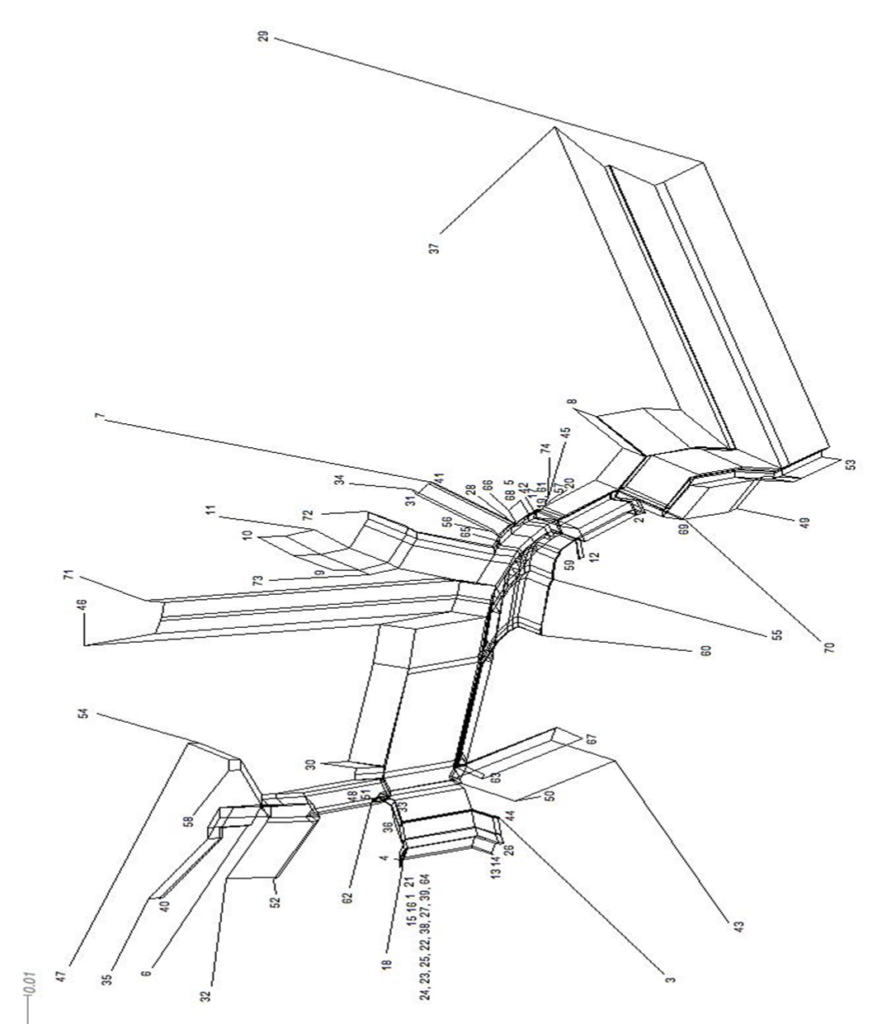
Coming back to chameleons, I have the problem that, being interested in the creatures, I want to know what they are. Having familiarized ourselves (my wife and I) with the Cape Dwarf (Bradypodium pumilum) we came into contact with the (then) Robertson Dwarf (B. gutturale now Little Karoo dwarf). The distribution given by W R. Branch and the descriptive detail did not seem to match what we were experiencing in the field and we concluded that the Robertson Dwarf and the Karoo Dwarf (B. karroicum) were surely the same species. We then encountered what we thought was the Western Dwarf (B. occidentale) and were derailed by the opinion given us from a DNA analysis of the “population” observed, that it was a variant of the Cape Dwarf viz. a “renosterveld form”. What we were told did not satisfy our “gut-feel” however profound and true it may have been or is. Then the booklet was published that confirmed our conviction that the Robertson and Karoo Dwarves were being confused (The true Karoo dwarf is now said to equate the E cape dwarf B. ventrale!), but not throwing any more light on the question of the “Renosterveld form” of the Cape Dwarf.
We then learned of a chameleon in the Gouritz River valley. On seeing these we concluded that on morphological grounds they were not the Little Karoo Dwarf and had to fall within the ambit of the Swartberg and Eastern Cape Dwarves as accepted by Tolley and Burger. These are the chameleons “identified” by an authority as the Karoo Dwarf despite our submission of evidence why it was not. This led us back to the published DNA work and a paper by Tolley et al that discussed specifically the Eastern Cape Dwarves and a number of variants suggested being new species. My experience in Haworthia generated the strong “gut-feel” that this may be quite wrong as wide field experience suggests that species are highly complex systems that defy the conventional taxonomic approach. Further sampling would quite probably generate a host of still other variants and require explanation. It is quite obvious that the chameleons cannot be identified with certainty using morphological characters and this is equally true for Haworthia. My experience is that it is true for many plant genera. Nevertheless, I think that this is because morphological criteria are so heavily relied on with not enough reference to geographic distribution and a rational species definition, as opposed to an open-ended species concept. In another paper by Tolley et al, the two species B. melanocephalum and B. thamnobates are shown to be genetically identical, despite the fact that they are known to be morphologically different and geographically separated. Thus it was a pleasant surprise to find another article (Miller & Alexander (2009) that probes this question and speculates that it is possible that the DNA sequences used in the analysis may not be representative of the full genome. The available results of DNA sequencing for Haworthia suggest to me that those sequences are also not adequately or accurately representing a true or reasonable phylogeny. A problem I then also have is that a phylogram is a simple two-dimensional tree that is being drawn to illustrate the relationship of elements that are spread in at least two-dimensional space derived from change with time. In my opinion far too much is thus inferred from complex statistical procedures that generate a wholly theoretical diagram wholly beyond penetration by ordinary skepticism. I would suggest that the so-named bootstrap and posterior probability values may be subject to the same apparently many vagaries of multivariate statistical procedures that are not perhaps fully understood or even recognized by those who use them.
Dr. Rhamdhani suggested that I mention some of the limitations of the sequencing process that he lists:
1. mostly extant samples are used as these are only available for analysis (except in some cases fossil can be sequenced).
2. small sample size.
3. use of a few selective markers.
4. hybridization and incomplete lineage sorting distorts and complicates patterns.
5. appropriate analytical tools have not been formulated to handle the data and the above issue.
6. manipulation, misuse etc. of species concepts to justify desired results – this can be related to the “gut-feel” issue that this article raises.
I did complain about the problem of probing results published in complex technical papers when the results conflict with my “gut-feel”. The response was that “our eyes and our intuition are frequently tricked by the complexity of the real world…” This is flatly not true for Haworthia and I strongly suspect that it is not true for chameleons either. In Haworthia we are tricked by a very simplistic approach and the failure of taxonomic botany to serve interested parties. My kind authority I referred chameleons to also wrote “I know the genetic information may seem very confusing, but it is essential to remember that the genes tell us about genealogy and not morphological or behavioural similarity.” I have said before that the traditional approach of taxonomy was always to relate morphology, and whatever other information one could acquire, to phylogeny. It is an unlucky fabrication foisted on us by DNA sequencing that this is a new direction for classification. To totally believe that, say, less than a thousand base pairs on a tiny section of mitochondrial DNA is giving what must be seen as a final answer that defies the doubt of an observer is perhaps too much to ask.
An end point in my chameleon inquiry came when Dr. Tolley conceded (as most DNA experts now seem to be doing) “DNA is obviously not a final answer, and everyone that understands well how evolution works, already agrees on that. However, when used wisely, in connection with morphology (which is subject to phenotypic plasticity, strong selection, and local adaptation) it obviously can be useful in understanding the evolutionary history of organisms. We can use DNA to give us clues as to the evolutionary lineages, which sometimes can be the same as what we humans like to call “species”. For me, “species” is partly an artificial construct because evolutionary processes do not suddenly jump, and divide one thing into two species, there are gradual changes, and sometimes (more often than we care to admit), they do not fit in the box we have labelled “species”. She exposes the fundamental problem that no one probably understands properly how evolution works nor do any of us have the wisdom to use DNA information to best advantage.
References
Ashadee, K.M. & Alexander, G. L. 2009. Do dwarf chameleons (Bradypodium) show developmental plasticity. African Zoology 44:45-54.
Tolley, K.A et al. 2004. Phylogenetics of the southern Africa dwarf chameleons, Bradypodium (Squamata: Chameleionidae). Molecular Genetics and Evolution 30:354-365
Tolley, K.A. & Burger, M. 2007. Chameleons of Southern Africa. Struik, Cape Town.
Treutlein, J. et al. 2003a. Phylogenetic relationships in Asphodelaceae (subfamily Alooideae) inferred from chloroplast DNA sequences (rbcL, matK) and from genomic fingerprinting (ISSR). Taxon 52:193 207.
Treutlein, J. et al. 2003b. Evidence for the polyphyly of Haworthia (Asphodelaceae Subfamily Alooideae: Asparagales) inferred from nucleotide sequences of rbcL, matK. ITS1 and genomic fingerprinting with ISSR-PCR. Plant Biology 5:513-521.
Note. The Chamelion DNA study rests on the sequencing of about 40 individual specimens as opposed to the 1000 plus used for the former morphological revision. ♦
